Tài liệu ôn thi tuyển công chức tỉnh Tiền Giang năm 2014 - Môn Tiếng Anh - Ngạch: Cán sự và chuyên viên
1.1 Subject (chủ ngữ):
Chủ ngữ là chủ thể của hành động trong câu, thƣờng đứng trƣớc động từ (verb).
Chủ ngữ thƣờng là một danh từ (noun) hoặc một ngữ danh từ (noun phrase - một
nhóm từ kết thúc bằng một danh từ, trong trƣờng hợp này ngữ danh từ không đƣợc
bắt đầu bằng một giới từ). Chủ ngữ thƣờng đứng ở đầu câu và quyết định việc chia
động từ.
Chú ý rằng mọi câu trong tiếng Anh đều có chủ ngữ (Trong câu mệnh lệnh, chủ
ngữ đƣợc ngầm hiểu là ngƣời nghe. Ví dụ: “Don't move!” = Đứng im!).3
Milk is delicious. (một danh từ)
That new, red car is mine. (một ngữ danh từ)
Đôi khi câu không có chủ ngữ thật sự, trong trƣờng hợp đó, It hoặc There đóng vai
trò chủ ngữ giả.
It is a nice day today.
There is a fire in that building.
There were many students in the room.
It is the fact that the earth goes around the sun
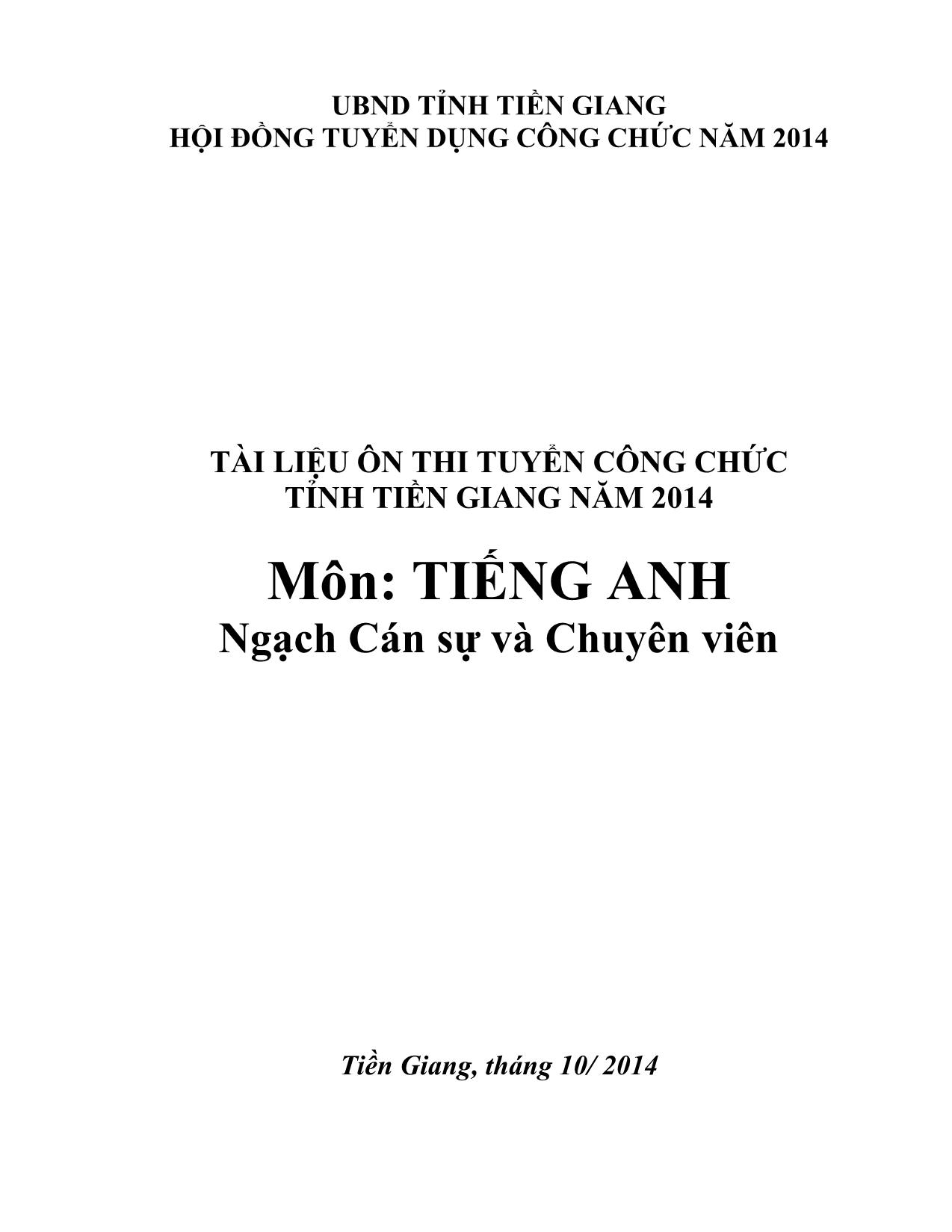
Trang 1
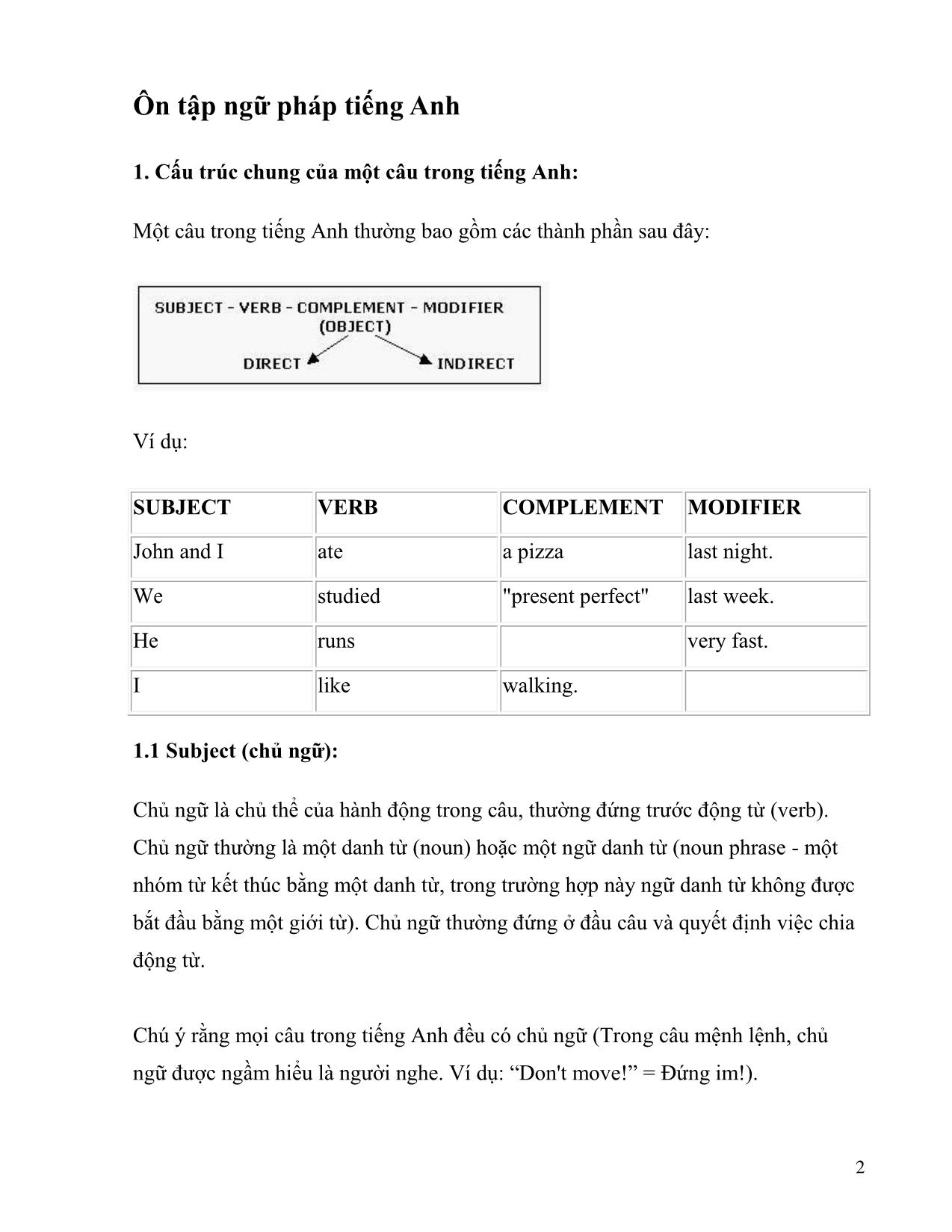
Trang 2
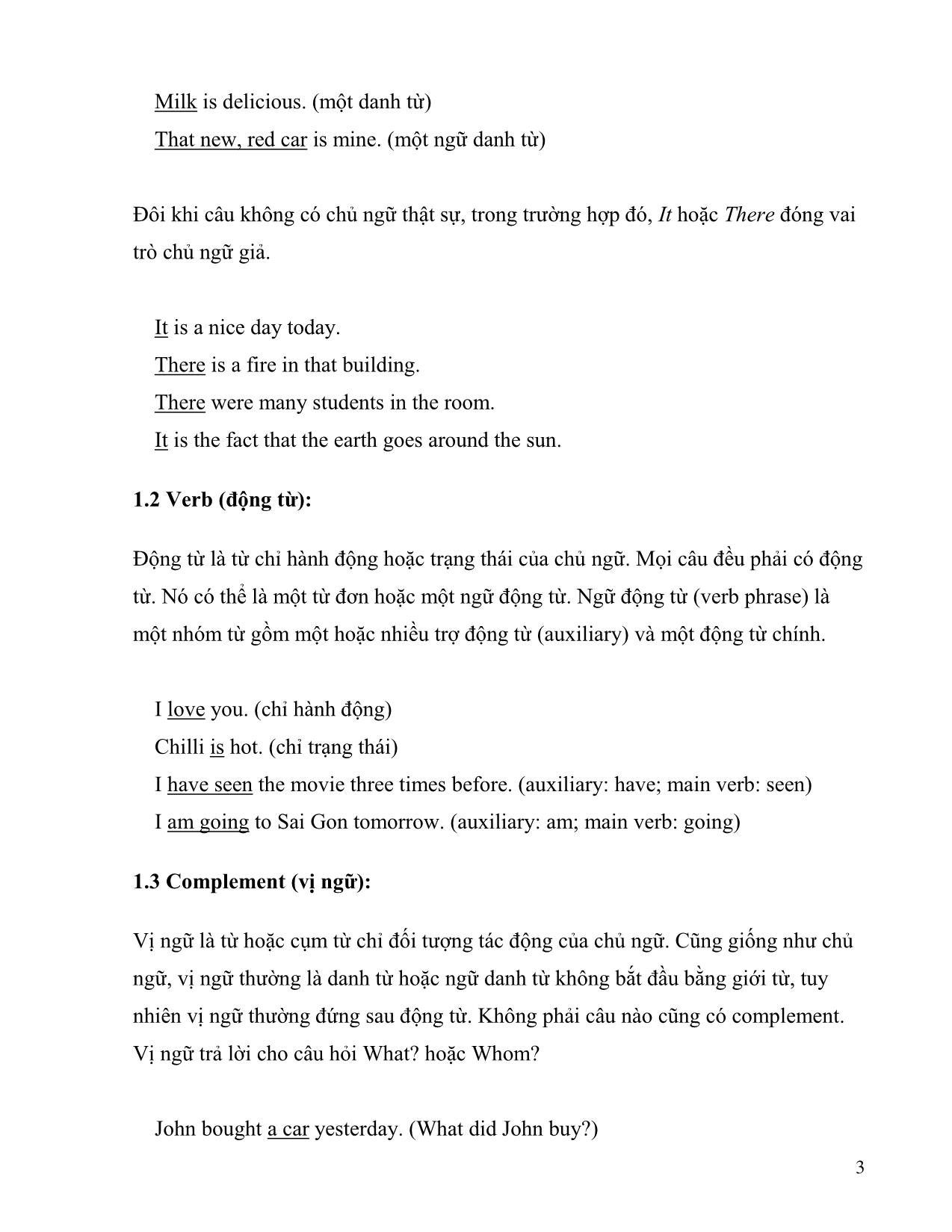
Trang 3
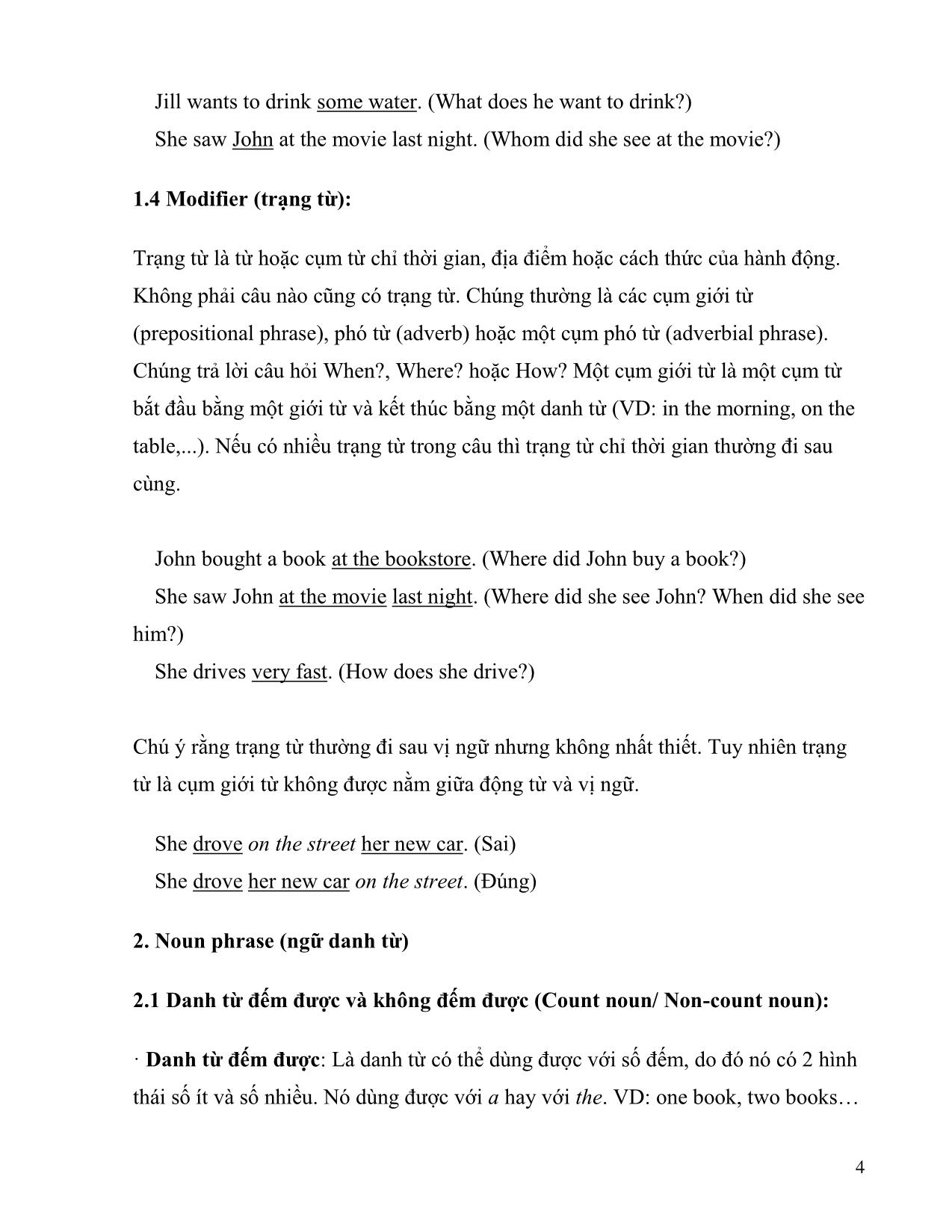
Trang 4

Trang 5
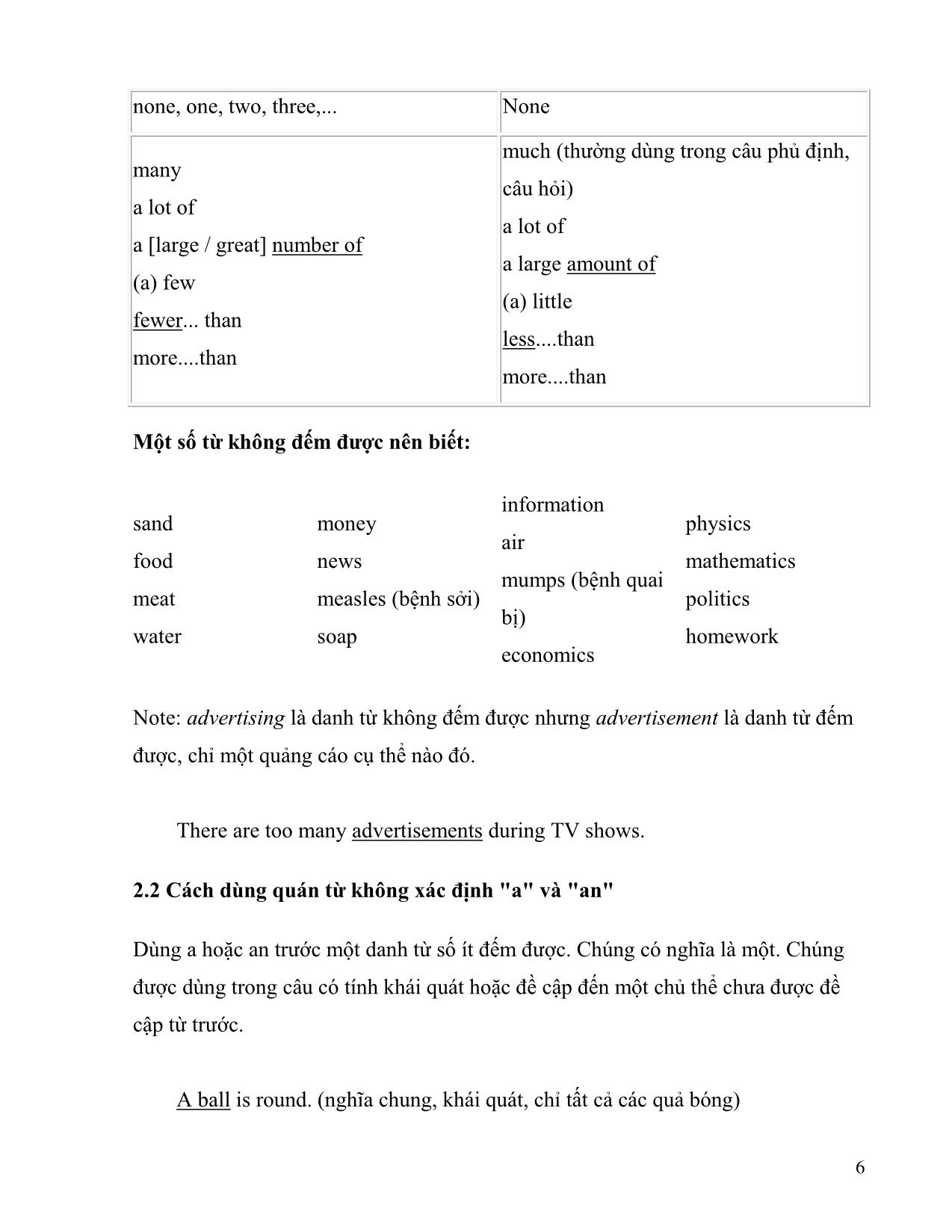
Trang 6
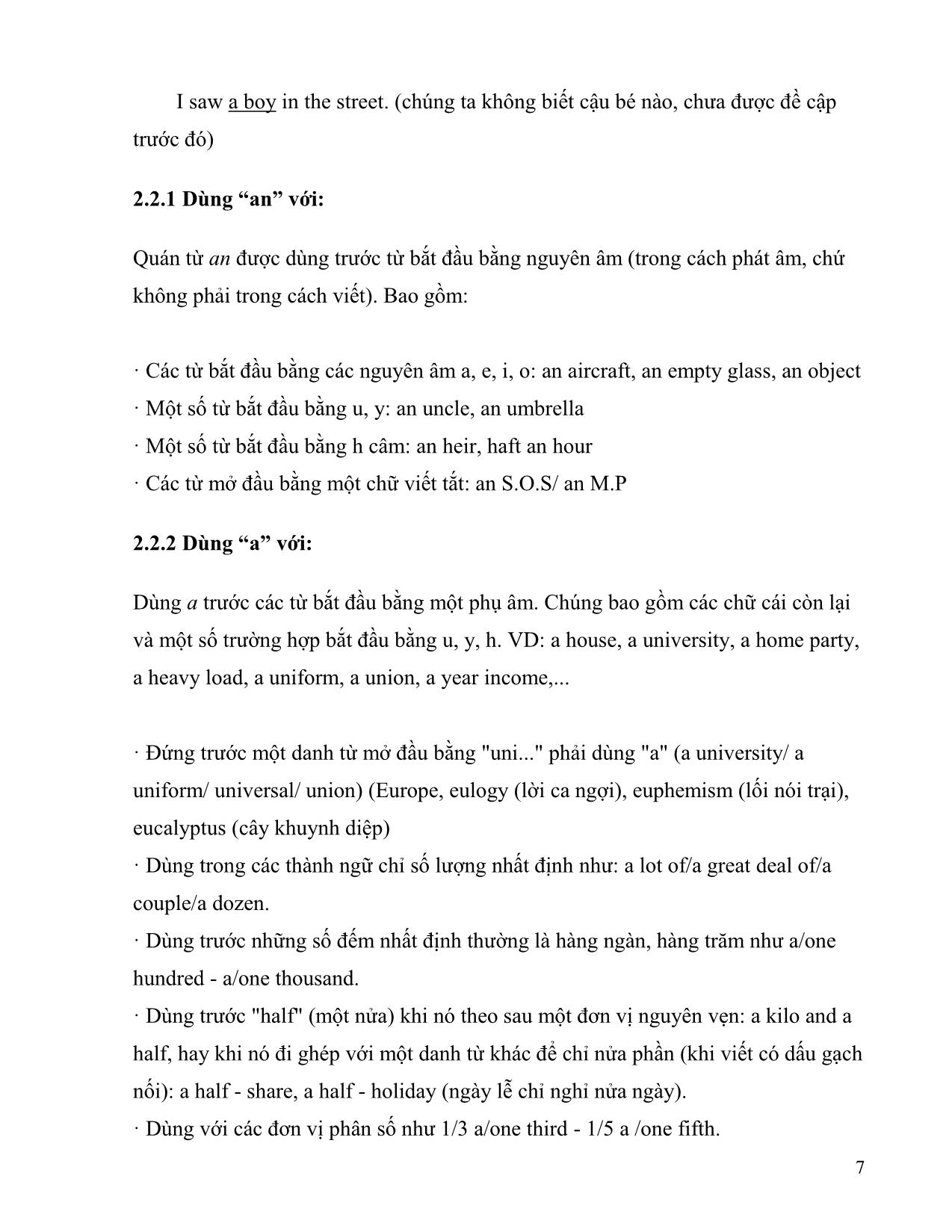
Trang 7
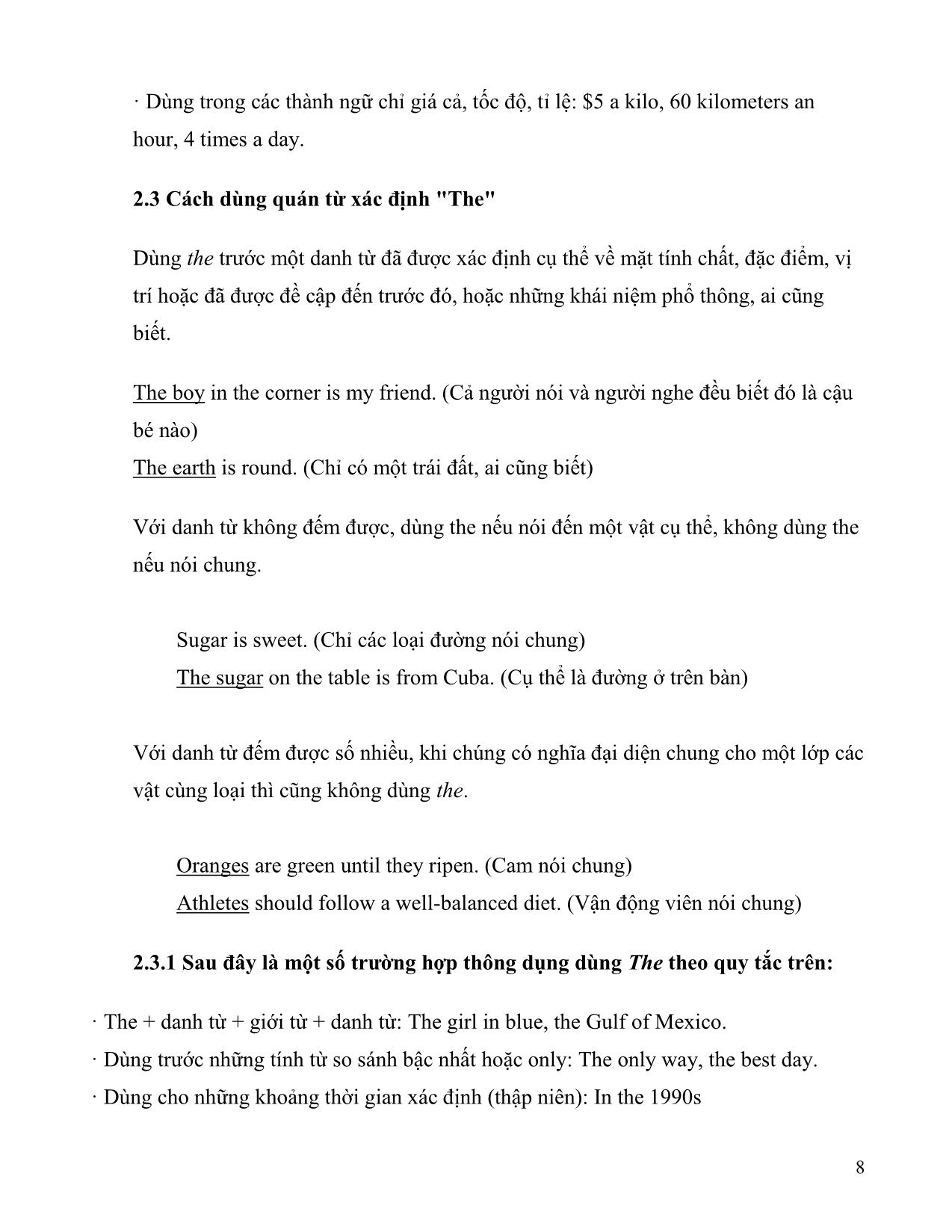
Trang 8
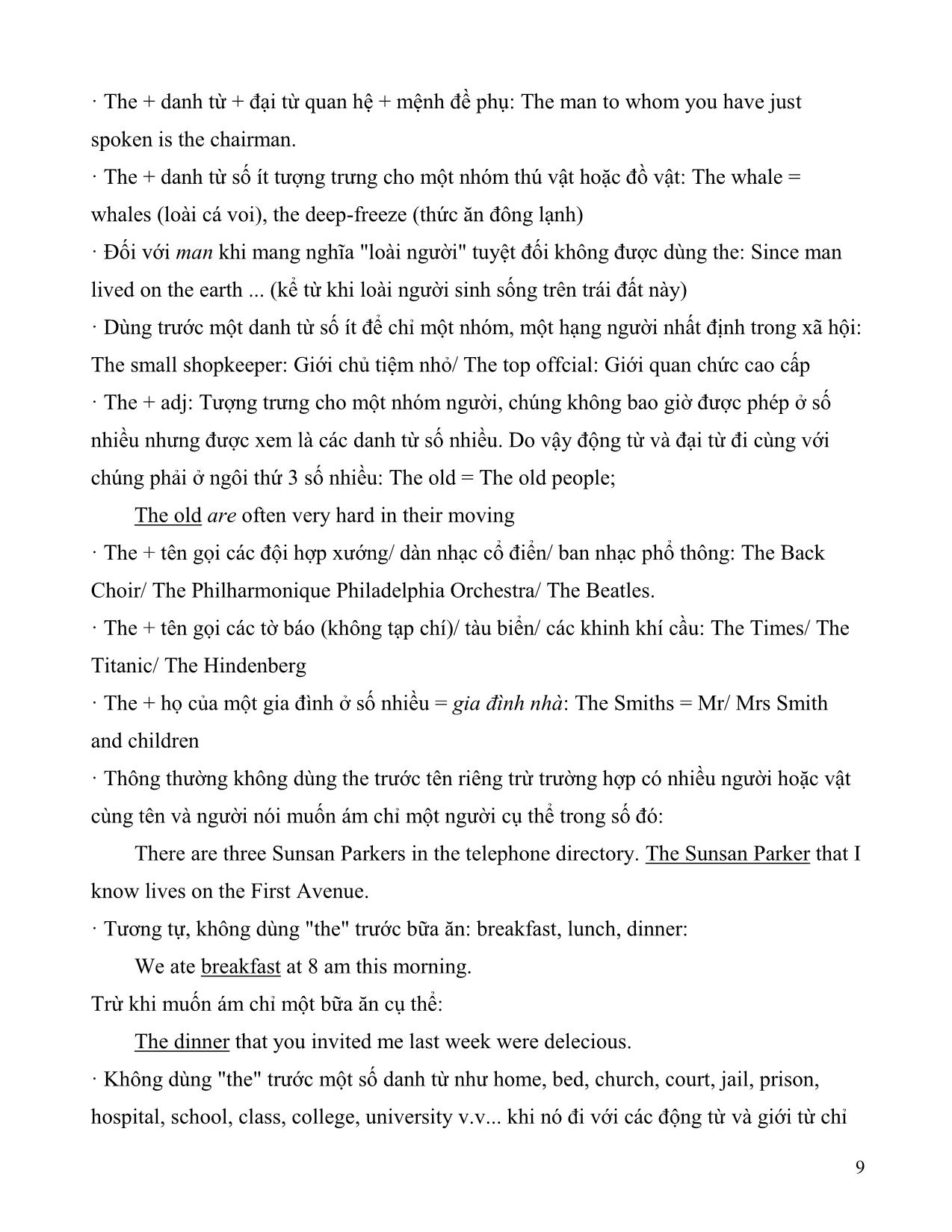
Trang 9
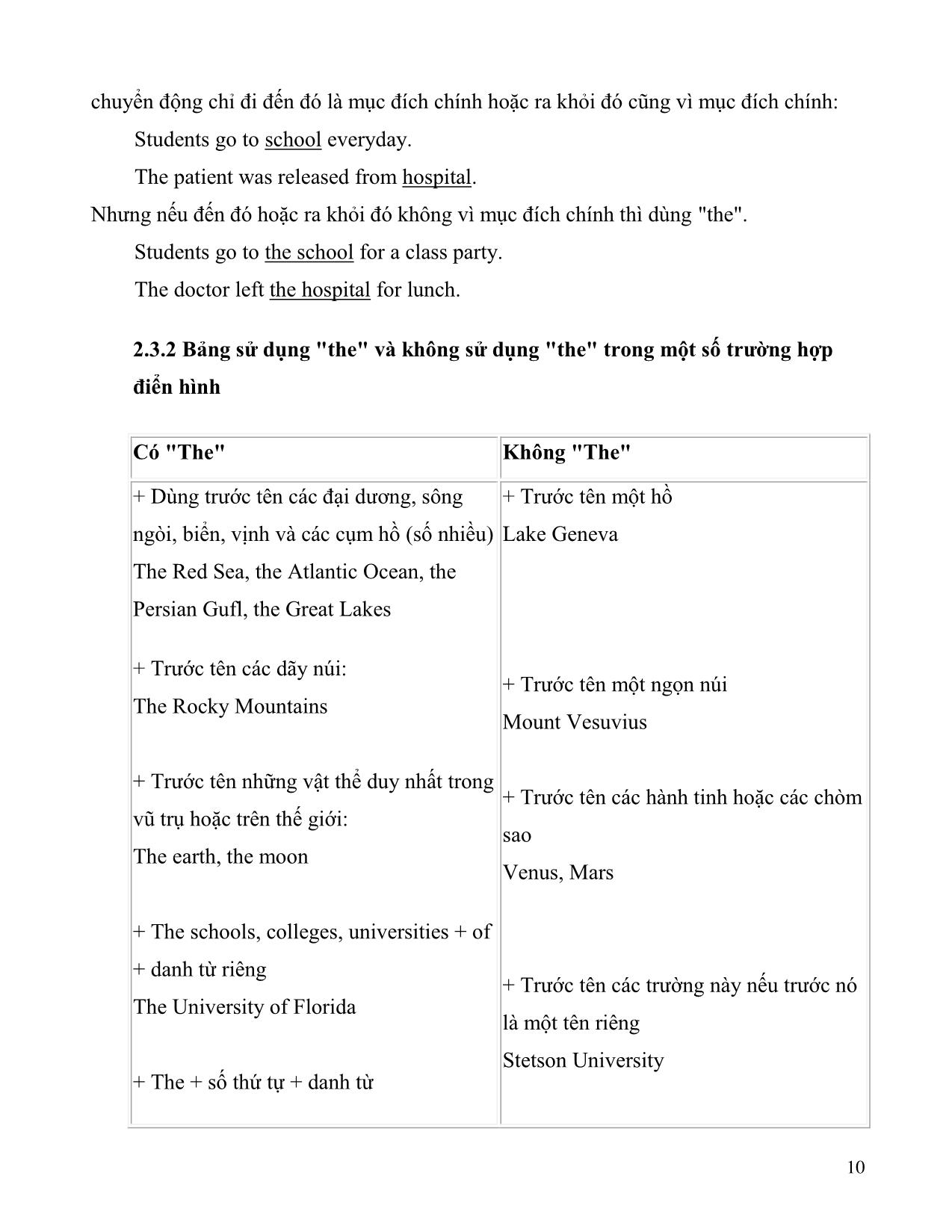
Trang 10
Tải về để xem bản đầy đủ
Tóm tắt nội dung tài liệu: Tài liệu ôn thi tuyển công chức tỉnh Tiền Giang năm 2014 - Môn Tiếng Anh - Ngạch: Cán sự và chuyên viên
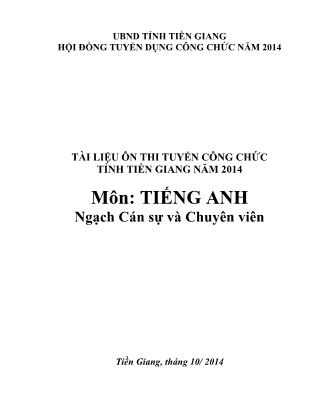
n? a. $1,555 b. $150,000 c. $15,000 d. $1,500,000 4. In what year was the construction probably begun on the canal? a. 1881 c. 1939 c. 1920 d. 1999 5. What can be inferred from this reading? a. This is costly project which should be reevaluated. b. Despite all the problems involved, the project is beneficial. c. Many captains prefer to sail around Cape Horn because it is less expensive. d. Due to all the problems, three governments have had to control the canal over the years. Test 3 During the teenage years, many young people can at times be difficult to talk to. They often seem to dislike being questioned. They may seem unwilling to talk about their work in school. This is a normal development of this age, though it can be very hard for parents to understand. It is part of becoming independent of teenagers trying to be adult while they are still growing up. Young people are usually more willing to talk if they believe that questions are asked out of real interest and not because people are trying to check up on them. Parents should do their best to talk to their sons or daughters about school work and future plant but should not push them to talk if they don‟t want to. Parents should also watch for the danger signs; some young people in trying to be adult may experiment with sex, drugs, alcohol or smoking. Parents need to watch for any signs of unusual behavior which may be connected with these and get help if necessary. This passage is taken from a 233 a. handbook for parents b. school timetable c. teenage magazine d. book for children 2. Why do adults sometimes find teenagers difficult to talk to? a. because most teenagers are quiet b. because teenagers don‟t want to talk to other people c. because teenagers think adults are not honest d. because most teenagers hate adults 3. When can you expect young people to be more talkative than usual? a. when people talk to them because they are really interested and not just checking on them b. when adults give them a lot of money to spend c. when adults talk to them about something other than their work in school d. when adults talk to them about sex, alcohol and drugs 4. Some teenagers experiment with drinking and smoking because a. cigarettes and alcohol are available everywhere b. cigarettes and alcohol are cheap c. women like smoking and drinking men d. they regard them as a mark of adulthood 5. The word behavior in the passage most nearly means a. feeling b. manners c. activities d. reaction Test 4 Take two tablets with water, followed by one tablet every eight hours, as required. For maximum nighttime and early morning relief, take two tablets at bedtime. Do not exceed six tablets in twenty-four hours. For children six to twelve years old, give half the adult dosage. For children under six years old, consult your physician. Reduce dosage if nervousness, restlessness or sleeplessness occurs. 234 1. The label on this medicine bottle clearly warns not to take more than a. twenty-four tablets a day. c. six tablets a day. b. eight tablets a day. d. three tablets a day. 2. We can infer by this label that a. the medicine could cause some people to feel nervous. b. children may take the same dosage that adults take. c. one may not take this medicine before going to bed. d. the medicine is a liquid. 3. If one cannot sleep, it is suggested that he a. take two tablets before going to bed. b. stop taking the medicine. c. take less than two tablets before going to bed. d. consult a doctor. 4. Evidently the medicine a. may be dangerous for small children b. may be taken by children but not by adults. c. can‟t be taken by children under 12. d. may be taken by adults but not by children. Test 5 After inventing dynamite, Swedish-born Alfred Nobel became a very rich man. However, he foresaw its universally destructive power too late. Nobel preferred not to be remembered as the inventor of dynamite, so in 1895, just two weeks before his death, he created a fund to be used for awarding prizes to people who had made worthwhile contributions to man kind. Originally there were five awards: literature, physics, chemistry, medicine and peace. Economics was added in 1968, just sixty-seven years after his first award ceremony. Nobel‟s original legacy of nine million dollars was invested, and the interest on this sum is used for the awards which vary from 30,000 dollars to 125,000 dollars. Every year on 235 December 10, the anniversary of Nobel‟s death, the awards (gold medal, illuminated diploma and money) are presented to the winners. Sometimes politics plays an important role in the judges‟ decisions. Americans have won numerous science awards, but relatively few literature prizes. No awards were presented from 1940 to 1942 at the beginning of World War II. Some people have won two prizes, but this is rare; others have shared their prizes. When did the first award ceremony take place? a. 1895 b. 1901 c. 1962 d. 1968 2. Why was the Nobel prize established? a. to recognize worthwhile contributions to humanity b. to resolve political differences c. to honor the inventor of dynamite d. to spend money 3. In which field have Americans received the most awards? a. literature b. peace c. economics d. science 4. In how many fields are prizes given? a. 2 b. 5 c. 6 d. 10 5. Which of the following statements is not true? a. Awards vary in monetary value. b. Ceremonies are held on December 10 to commemorate Nobel‟s invention. c. Politics can play an important role in selecting the winners. d. A few individuals have won two awards. Test 6 The early expansion of the sugar industry was based on cane transported from two different parts of the Orient, first from India and second from the islands of the Southwest Pacific. From India, sugar cane was carried through the western regions of Asia into Arabia and later into the countries bordering on the Mediterranean. It was established in 236 Sicily in about A.D. 703 and was carried to Spain in about A.D.755. As early as A.D. 1150, Spain had at least 75,000 acres of cane. During this early period sugar cane was grown largely to supply local wants. The Crusades were partly responsible for further expansion and improvement of the sugar industry and for interesting Europeans in the use of sugar. From this passage, sugar cane was first grown in a. Europe b. the Orient c. Arabia d. Sicily 2. Sugar cane was first introduced into Spain in a. A.D. 703 b. A.D. 755 c. A.D. 1150 d. A.D. 1419 3. In the twelfth century, most cane was grown a. for exportation b. for industrial uses c. for sale in the large market cities d. for local use 4. One thing that caused the sugar industry to expand in Europe was a. the favorable climate in the Orient b. the Crusades c. better means of transportation d. that came from the different parts of the Orient 5. Cane was transported a. from the island of Southwest Pacific, to India, to Asia and then to Spain b. from the island of Southwest Pacific, to the western areas of Asia and then to the countries bordering the Mediterranean c. from India to the Southwest Pacific, to Asia, into Arabia and then to the countries bordering the Mediterranean d. from India, to Asia, into Arabia and then to the countries on the border of the Mediterranean Test 7 237 Different types of relationships exist between living things. One type of relationship is parasitism, in which one partner benefits while the other loses. A very different type of relationship is symbiosis, in which both partners benefit. An example of a parasitic relationship exists between the stone crab and sacculina, a type of barnacle. The sacculina attaches itself to the stone crab. It then eats into the crab, and the stone crab becomes disabled. An example of a symbiotic relationship exists between the hermit crab and the calliactis anemone. The anemone attaches itself to the crab, but it is not a parasite because it does not harm the crab; it feeds on food that is dropped by the crab. The anemone even helps the crab by protecting the crab from other predators with its tentacles. The subject of this passage is a. two different kinds of relationships between living things b. parasitic relationships c. relationships that are mutually beneficial to living things d. symbiossis Which of the following is NOT true about parasitic relationships? a. There are two partners in a parasistic relationship. b. One partner in a parasitic relationship hurts the other. c. The stone crab can be part of a parasitic relationship. d. A parasitic relationship is usually symbiotic. According to the passage, what does sacculina eat? a. The stone crab b. Barnacles c. Food dropped by the crab d. Other parasities The calliactis anemone a. is a parasite b. harms the hermit crab c. eats into the hermit crab d. assists the hermit crab 238 Which of the following can be inferred from the passage? a. All crabs are involved in parasitic relationships. b. All crabs are involved in symbiotic relationships. c. Some crabs are involved in symbiotic relationships, while others are not. d. Crabs are involved in neither parasitic nor symbiotic relationships. Test 8 The three phases of the human memory are the sensory memory, the short-term memory, and the long- term memory. This division of the memory into phases is based on the time span of the memory. Sensory memory is instantaneous memory. It is an image of memory that enters your mind fleetingly. It comes and goes under a second. The memory will not last longer than one second unless the information enters the short-term memory. Information can be held in the short-term memory for about twenty seconds or as long as you are actively using it. If you repeat a fact to yourself, that fact will stay in your short- term memory as long as you keep repeating it. Once you stop repeating it, either it is forgotten or it moves into long- term memory. Long- term memory is the almost limitless memory store that can hold ideas and images for years and years. Information can be added to your long- term memory when you actively try to put it there through memorization or when an idea or image enters your mind on its own. The three phases of memory discussed in this passage are different according to: a. Location in the brain b. The period of time it takes to remember something c. How the senses are involved in the memory d. How long the memory last According to the passage, which type of memory is the shortest? a. Sensory memory c. Active memory b. Short-term memory d. Long-term memory 239 3. The word “fleetingly” is closest meaning to which of the following? a. Easily c. Temporarily b. Slowly d. Fundamentally 4. According to this passage, when will information stay in your short-term memory? a. For as long as twenty minutes b. As long as it is being used c. After you have repeated it three times d. When it moves into long-term memory 5. According to the passage, what is the capacity of long-term memory? a. Limited c. Equal to the capacity of short-term memory b. Infinite d. Very large Test 9 Five bodies of water make up the chain of lakes called the Great Lakes. Each of these five lakes is among the fifteen largest lakes in the world. The largest of these lakes is Lake Superior, followed by Huron, Michigan, Erie, and Ontario. Lake Michigan is located entirely within the United States, but the other four lakes form a part of the boundary running between the United States and Canada. These freshwater lakes form a waterway more than 1,000 miles long, which is as busy as, if not busier than, any other waterway in the world. Canals have been dug to make the lakes a better waterway. These canals permit large, ocean-going vessels loaded with grain, iron ore, and coal to reach the lakes. 1. Which statement is true of the Great Lakes? a. All of the lakes are located within the United States. b. The lakes have salty water. 240 c. Many ships sail the lakes. d. Lake Superior is the fifteenth largest lake in the world. 2. Which of the following is not a name of one of the Great Lakes? a. Erie b. Michigan c. Huron d. Canada 3. The canals were dug for what purpose? a. To improve the lakes as a waterway. b. To form a boundary between the United States and Canada. c. To make all of the lakes among the fifteen largest lakes in the world. d. To keep fresh water in the lakes running. 4. Which of the five Great Lakes is the largest? a. Huron b. Ontario c. Superior d. Erie 5. “make up” most nearly means a. develop b. form c. cause d. decorate Test 10 Forty-five people were made homeless in a fire that destroyed a row of shop-houses in Randford Road yesterday. The damage was estimated at $ 150,000. Police said nobody was injured during the fire with lasted two and a half hours. Three shops and a house were destroyed by the fire. The fire starts at about 11.50 a.m. at the back of the bakery shop. Within fifteen minutes the shops on either side of the bakery were on fire as well as a house at the back of the row of shops. Three fire engines rushed to the fire and huge crowded soon arrived to watch. Mr Jacob Isaacs, 29, said, “I left home at 10 a.m. and when I returned I was shocked to see my house on fire.” Another victim of the fire, Miss Elaine Farrel, 49, said, “I went for a cup of tea and returned to see my house on fire. The fire was too strong and we could not save anything. All we could was to stand and watch.” What happened in Randford road yesterday? Forty-five people destroyed the shop-houses. 241 Forty-five people made a fire. There was a fire there. Forty-five people fired at the shop-houses How were the people affected in the accident? a. A lot of them were injured. b. The fire destroyed $ 150,000 worth of property. c. Almost all the shop-houses were destroyed. d. The damage was slight. 3. Where did the fire start? a. at about 11.50 a.m. b. at the kitchen of a bakery shop. c. at the back of the rows of shops d. at the back of a bakery. 4. The word “fire-engines” in the text means a. vehicles which were rescued from the fire. b. special vehicles carrying equipment for fighting fires. c. vehicles which were damaged in the fire. d. special vehicles for saving the victims of the fire. 5. What did Miss Farrel do on finding her house was on fire? a. She went out for a cup of tea. b. She was shocked to see her house on fire. c. She tried to fight the fire. d. She simply stood watching helplessly. THE END
File đính kèm:
 tai_lieu_on_thi_tuyen_cong_chuc_tinh_tien_giang_nam_2014_mon.pdf
tai_lieu_on_thi_tuyen_cong_chuc_tinh_tien_giang_nam_2014_mon.pdf

